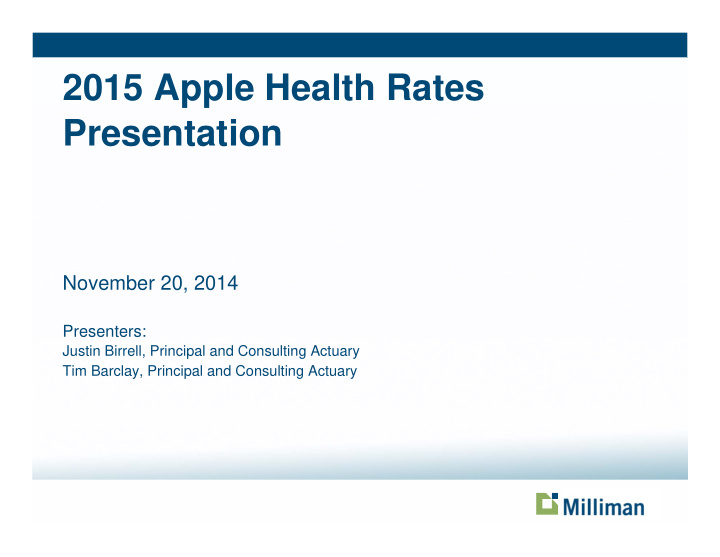



2015 Apple Health Rates Presentation November 20, 2014 Presenters: Justin Birrell, Principal and Consulting Actuary Tim Barclay, Principal and Consulting Actuary
Agenda Policy/Rate Structure Issues General Rate Development Topics Risk Adjustment Process Family and SCHIP Rates Blind/Disabled and COPES Rates Blind/Disabled/COPES Care Management Expansion Pricing Expansion Risk Mitigation 2
Policy/Rate Structure Issues SCHIP now separate from other Family COPES now separate from other Blind/Disabled Aggregation of Minimum Loss Ratio for: • Family • SCHIP • Blind/Disabled • COPES Hepatitis C drugs excluded for all populations DCR & LBW payments will apply to SCHIP as well as Family DCR will apply to Expansion population Reallocation of SNAF funding by program 3
General Rate Development Topics Applied PMPM Trends Sources include: • WA Per Caps FFS forecast models for TANF and Disabled clients • Milliman FFS and MCO ARIMA models for non-COPES equivalent clients • Multiple years of HO MCO data • Observations from other similar programs • Actuarial Judgment 4
General Rate Development Topics Completion Factors Table II-2 Washington Health Care Authority Family Completion Factors Service Line AH Family AH BD AH AC 1.094 1.481 Hospital Facility 1.102 1.058 1.502 Professional/Other 1.046 1.000 1.001 Pharmacy 1.001 Notes: • AH Family includes the new Family and SCHIP populations. • AHBD includes the new BD and COPES populations. • AHAC (Apple Health Adult Care) is the expansion population. • Factors computed and applied separately by MCO. Composites shown here. 5
General Rate Development Topics Added Benefits in 2015 • Bariatric Surgery • Hearing Aids Added Benefits in 2014 • RSN Drugs paid FFS in 2013 • Removal of hemophilia drugs • SBIRT • Shingles Vaccine • Naturopath Provider Expansion • MH ER Visits • Health Home Removed in 2015 • Hepatitis C Drugs • ARNP Enhancement 6
General Rate Development Topics Non-Medical Expense Loads Revised Expense Allocation reduced DCR and LBW Table II-4 Washington Health Care Authority Non-Medical Load AH Component AH BD Expansion Family Administration 8.5% 6.5% 8.0% Surplus 1.5% 1.5% 1.5% Requirements WSHIP $1.03 $1.03 $1.03 Assessment Premium Tax 2.0% 2.0% 2.0% ACA Insurer 0.0% 0.0% 0.0% Tax 7
Risk Adjustment Process More refined approach Age/Gender and County specific factor normalization Reduced credibility thresholds given greater age/gender/geographic precision Blended results by region Performed separately for Family, SCHIP, AHBD and COPES populations 8
Family and SCHIP Rates Collective MCO experience below target Assumed 5% ER visit reduction Rate change excluding pass-through items: • Composite -0.9% • Family -1.1% • SCHIP 11.1% Rate Change including pass-through items: • Composite -1.0% • Family -1.0% • SCHIP -1.3% LBW now triggers using APR-DRG coding New minimum LBW paid amount of $75,000 9
Blind/Disabled and COPES Rates Collective experience above target Rate change excluding pass-through items: • Composite 10.6% • AHBD 4.3% • COPES 81.5% Rate change including pass-through items: • Composite 12.5% • AHBD 6.7% • COPES 78.9% 10
Blind/Disabled/COPES Care Management MCO experience presents Cost Effectiveness challenge Credibility concerns with emerging 2014 experience Data shows utilization management limited to date Emergency Room Utilization (NYU Categorization) 2014 MCO FY 2012 FFS Non-Copes COPES Non-Copes COPES Non-Emergent 33% 30% 34% 30% Emergent/Primary Care Treatable 37% 36% 37% 36% Emergent - ED Care Needed - Preventable/Avoidable 12% 12% 11% 10% Emergent - ED Care Needed - Not Preventable/Avoidable 18% 22% 18% 25% Inpatient Utilization (AHRQ Categorization) 2014 MCO FY 2012 FFS Non-Copes COPES Non-Copes COPES Avoidable Admissions 16% 18% 16% 16% Readmissions 13% 13% 12% 15% 15% DoHM improvement assumption for 2015 11
Expansion Pricing Transitional and New member costs very different New member variability by MCO ties to risk adjustment indicators Transitional member variability by MCO does not tie well to risk adjustment Distribution of transitional members and new members is inconsistent between MCOs Significant uncertainties in costs going forward: • What will the future mix look like? • Will new member experience deteriorate as they regress to the mean or become more engaged? • Will new member experience improve with diminished adverse selection and pent up demand? • Will we retain an ability to identify transitional members over time? Must revisit the risk mitigation model 12
Expansion Risk Mitigation 1:00 call with CMS earlier today What did we learn? Where do we go from here? 13
Limitations This analysis is intended for the use of HCA in support of the 2015 Apple Health capitation rate development. Any user of the data must possess a certain level of expertise in actuarial science and health care modeling so as not to misinterpret the data presented. Milliman makes no representations or warranties regarding the contents of this email to third parties. Similarly, third parties are instructed that they are to place no reliance upon this analysis prepared for HCA by Milliman that would result in the creation of any duty or liability under any theory of law by Milliman or its employees to third parties. Other parties receiving this report must rely upon their own experts in drawing conclusions about the Washington capitation rates, assumptions and trends. It is the responsibility of any individual MCO to establish required revenue levels appropriate for their risk, management and contractual obligations. This analysis has relied extensively on data provided by the participating MCOs and HCA. Errors in data reporting may flow through the analysis, and as such would impact the results. Actual results will vary from our projections for many reasons, including differences from assumptions regarding provider negotiated discounts, the degree of health care management, and the level and mix of managed care enrollment, as well as other random and non-random factors. Experience should continue to be monitored on a regular basis, with modifications to rates or to the program as necessary. Actuarial Statement of Qualification Guidelines issued by the American Academy of Actuaries require actuaries to include their professional qualifications in all actuarial communications. I am a member of the American Academy of Actuaries, and meet the qualification standards for performing this analysis. 14
Recommend
More recommend